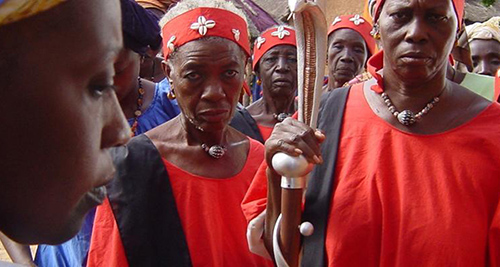Film critic Delali Adogla-Bessa delves into Ousmane Sembene’s legendary Moolaade. Enjoy!
Largely considered the finest African filmmaker, Ousmane Sembène, was 81 when he made Moolaadé in 2004. Over here, the late Senegalese director and “the father of African cinema” tells a very African story but one that will definitely resonate far beyond as it narrows in on the canker of female genital mutilation (FGM) in a confluence of traditional and Muslim African society.
Sembene is definitely against FGM and his central character, Colle (Fatoumata Coulibaly) embodies his graceful resistance against this outmoded and domineering practice. Early in the film, we see her give refuge to four girls who have escaped an FGM ritual. Some ways into the film we see these girls had good reason to be quite terrified as Sembene serves us subtle but still effective scenes of the ostensive revulsion of FGM. We don’t get anything too graphic save for the visceral cries of some of the girls who do go through the ritual.
I always think of this class I took in university that narrowed in on FGM. Our lecturer, a woman, made the class so incredibly primeval it sent chills up my spine. Sembene, in some respects, is relying on some degree of empathy and relatability from his audience. It is one of the reasons he just jumps into the conflict without bothering to explain issues to the sections who regard FGM as a distant concept. The familiarity with FGM also means his audience firmly understands the motivations of Colle as she shields the four girls from the institution of FGM which is mostly represented by women.
Colle herself was mutilated as a child but she refused to let her own daughter, Amasatou (Salimata Traore) be cut. However, we also learn undergoing the mutilation ritual is a key part of finding a husband in this traditional society. The men want their women circumcised because maybe they feel a frigid woman will make a better wife, that’s the reasoning I’ve encountered over the years. African culture is patriarchal. Most cultures are, to be honest. It’s easy to say FGM serves only the men because it does and because of the tie in Sembene creates here with suitability and marriage.
I should also mention Collie’s adolescent daughter is up for marriage. She is engaged to a man returning home from France – the chief’s son, a prince as it were. It is easy to see the educated white suit wearing man riding in to become the progressive voice against the outmoded female circumcision but Sembene doesn’t opt for the low hanging fruit. He understands the importance of having the women speak up for themselves. It is important to our director that the women stand up for themselves. There is no white priest preaching Christianity. The four girls run to a woman not a man for refuge despite the patriarchy. We are carefully gifted women, led by Colle, who speak up in humanist splendor.
Early in the film, we see Colle invoke moolaadé by tying a strip of red and black cloth across the entrance to her mud hut compound. She does this to protect the girls who come terrified for shelter. Custom dictates that under moolaadé, as long as the girls stay inside her compound, no one can enter after them. Colle is, of course, married herself, a second wife and her husband are enraged by this as he comes under pressure from the society and his elder brother to put his junior wife in order. He can’t do much, though. The women here have power paradoxically stemming from the customs that promote FGM.
The fact that the women here are able to keep the men and societal customs at bay is quite unworldly, sometimes funny. It’s a play by Sembene on the boldness they exhibit which comes with some form of respect and fear from the men. It’s almost a mental battle here which is why we also see radios take centre stage here. The women get a fix of enlightenment and listen to other free talking women from the cities on the radio. It is telling that the only plays of aggression (save for a whipping scene) from the men are geared towards stripping the women of their cordless radios. We never see the men burst in to seize the four runaway girls but we do see the radio seized, piled up and burnt.
More aggression is linked to a character known as Le Mercenaire (Dominique Zeida). He is an outsider, educated, promiscuous and from the city. He has a small shop where he sells batteries to power the radios. He also doesn’t shy away from voicing thoughts that will align with some of us regular folks – *cough pedophilia cough*. The radios and Le Mercenaire are the cause of all the troubles as far as the all-male village council is concerned because they do not align with custom. Bear in mind that the core dissent here is anchored in customs but the men cannot be seen to be attacking culture can they.
What we ultimately have here is a nuanced view of a culture that exhibits disdain for the abhorrent aspects and reverence for the noble bits. There is an endearing simplicity that trumps the limited acting from this predominantly amateur cast and blunt grandstanding. Aside from the core narrative, there is some sociological insight into experiencing this rural Senegalese culture as the film builds from Colle’s compound out. The architecture here, modeled like Larabanga mosque, is packaged nicely and presented in all its countryside splendor shot in a wealth of striking colors.
Sembene does angle towards a political stance quite intelligently in Moolaadé but having a central character like Colle really offers character layers to connect to and pick at as the narrative unravels. Our director won’t tolerate us settling for outsider status here and he tries his best to draw us in with a true humanist spirit and I reckon he does so successfully.
You can read more of Delali’s articles at Broken Cliche.






